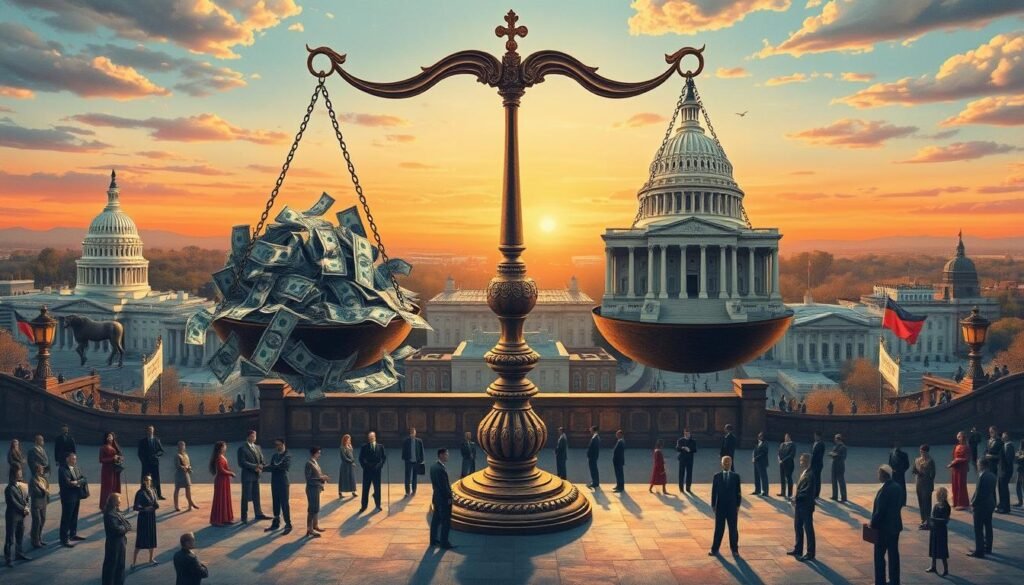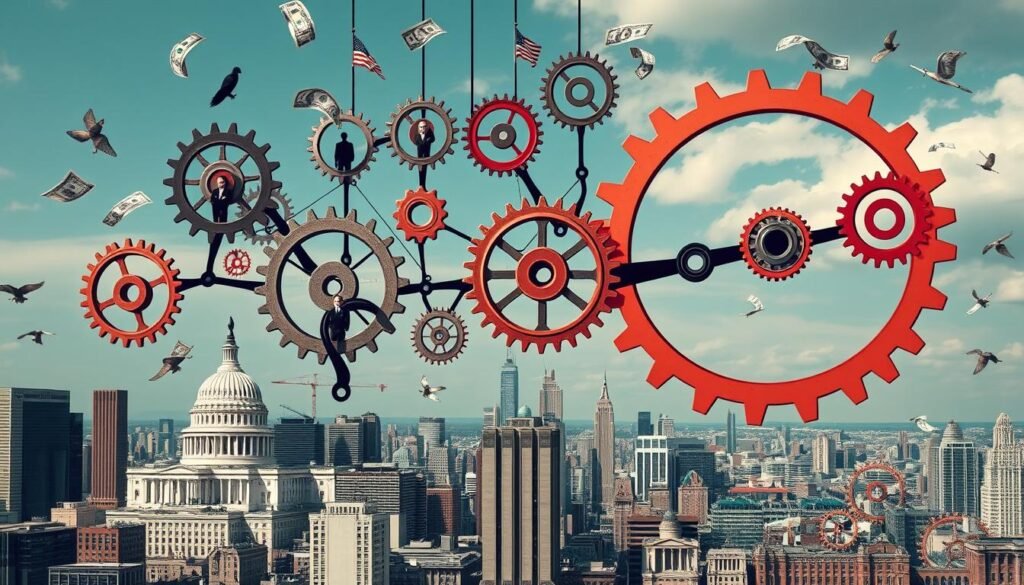The Effectiveness of Political Action Committees in Shaping Policy
PACs have spent a huge $5.89 billion in the current election cycle by mid-September 2022. This shows how much money PACs can influence elections. Understanding how PACs shape policy is key to grasping their role in American politics. About 40% of candidate funding comes from PACs and related groups.
Traditional PACs can give up to $5,000 per candidate per cycle. But Super PACs can spend as much as they want on ads. This big change in funding has made PACs more powerful in elections. PACs focus on important races and politicians, affecting key issues for their areas.
Key Takeaways
- PACs have spent a total of $5.89 billion in the current election cycle.
- Approximately 40% of the funding for candidates comes from PACs and affiliated organizations.
- The average contribution limit set for traditional PACs is $5,000 per candidate for each election cycle.
- Super PACs allow for unlimited spending on independent advertisements.
- PAC influence on policy is substantial, with PACs often targeting key electoral races and politicians.
- The Effectiveness of Political Action Committees in Shaping Policy can be seen in their ability to shape legislative agendas and influence economic policy-making.
- PACs have raised $6.15 billion for the current election cycle, while individual candidates have raised $2.4 billion.
Understanding Political Action Committees: A Fundamental Overview
Political Action Committees (PACs) are key in shaping policy in the United States. They collect and give money to support political candidates. This is often based on the interests or goals of the PAC. PACs play a big role in policy formation, affecting what elected officials decide.
Definition and Basic Structure of PACs
PACs gather money from people or groups to back political candidates or causes. They can be set up by corporations, labor unions, or other groups. A PAC usually has a treasurer, chairman, and a board of directors.
Types of PACs
There are many kinds of PACs. Connected PACs are linked to corporations, unions, or trade groups. Non-connected PACs are independent and not tied to any group. Super PACs can raise and spend unlimited funds to support or oppose candidates.
| Type of PAC | Description |
|---|---|
| Connected PAC | Started by a corporation, union, or trade group |
| Non-connected PAC | Stands alone and not tied to any group |
| Super PAC | Can raise and spend unlimited funds for candidates |
In summary, understanding PACs in politics and their role in policy is key. Knowing about the various PAC types and their structures helps us see their impact on politics.
Historical Evolution of PACs in American Politics
The 1970s saw the creation of the Federal Election Committee (FEC). This was a big step in regulating campaign finance and the impact of Political Action Committees on policy making. The FEC aimed to stop financial abuses in political campaigns. But, several Supreme Court cases have limited its power, leading to more spending by PACs.
To understand PACs today, we must look at their history. The Political Action Committees impact on elections has grown a lot. PACs now play a big role in shaping policy. Here are some key moments in PAC history:
- The 1974 amendments to the Federal Election Campaign Act (FECA) capped individual donations to candidate campaigns at $1,000 per election.
- PAC donations to campaigns were capped at $5,000 as per the 1974 amendments.
- Spending limits were set at $10 million for a primary election and $20 million for a general election following the 1974 amendments.
The history of PACs is filled with changes in campaign finance laws. Knowing these changes helps us understand today’s Policy making landscape. The Political Action Committees impact on elections keeps growing. PACs are now key in shaping policy.
| Year | Event | Impact on PACs |
|---|---|---|
| 1970s | Creation of the FEC | Regulation of campaign finance |
| 1974 | Amendments to FECA | Capped individual and PAC donations |
| 2002 | Bipartisan Campaign Reform Act (BCRA) | Prohibited national political party committees from raising or spending non-federal funds |
The Mechanics of PAC Influence in Policy Formation
PACs have a big role in shaping policy. They do this through direct campaign contributions, lobbying, and developing electoral strategies. They can spend on ads, help get people to vote, and research election issues.
It’s important to understand how PACs influence policy. They work closely with political lobbying. This is because PACs often try to shape policy through lobbying.
Direct Campaign Contributions
PACs can give up to $5,000 to a candidate per election. They can also give up to $15,000 a year to a national party. These donations can greatly affect election outcomes, thanks to other forms of support.
Lobbying Activities
PACs lobby to change policy. They focus on lawmakers who might agree with them. This strategy can be very effective in shaping policy.
The number of PACs has grown a lot. In 1972, there were 113 PACs. By 1988, there were 4,268. Contributions to candidates also increased a lot. From $8.5 million in 1971-1972 to $151.3 million in 1987-1988.
Financial Impact: Following the Money Trail
Political Action Committees (PACs) spend billions in each election cycle. Policy influence by Political Action Committees is key to understanding their role. In the 2022 election cycle, PACs have spent $5.89 billion. Half of this came from hybrid PACs.
The Effectiveness of Political Action Committees in Shaping Policy is clear in their spending. For instance, AIPAC has invested in over 80% of congressional seats up for election in 2022. This totals 389 races. Such spending shows the big financial role PACs play in policy.
Here’s a look at AIPAC’s spending:
- AIPAC targeted 363 House seats and 26 Senate seats in 2022.
- AIPAC aims to spend $100 million on elections in 2024.
- AIPAC PAC backed 233 Republican candidates with over $17 million. It also supported 152 Democratic candidates with more than $28 million.
The financial impact of PACs is vital to understanding their policy influence. By tracing the money, we see how Effectiveness of Political Action Committees in Shaping Policy. They play a big role in the political scene.
| PAC | Spending | Candidates Supported |
|---|---|---|
| AIPAC | $5.89 billion | 389 |
| Hybrid PACs | $2.945 billion | 50% of total spending |
The Effectiveness of Political Action Committees in Shaping Policy: Analysis and Evidence
PACs play a big role in US politics. To grasp their impact, we need to look at the data. A study found 68 papers that show PACs are getting more attention in policy discussions.
Key statistics include:
- Total papers produced from systematic search: 4,731
- Papers included for analysis and synthesis: 68
- Number of databases searched: 6
The study used a framework to guide its review. This framework helps us understand how PACs influence policy. It looks at the extent and range of their advocacy.
Recent years have seen a big jump in election spending. This money comes from fewer donors, who give more. This raises questions about fairness in policy decisions and the role of wealth.
| Year | Election Spending | Number of Donors |
|---|---|---|
| 2010 | $4 billion | 100,000 |
| 2020 | $14 billion | 50,000 |
The data shows PACs have a big impact on US politics. This has big implications for policy. More research is needed to understand their full impact and find ways to make things fairer.
Corporate PACs versus Ideological PACs
There are big differences between corporate PACs and ideological PACs. Corporate PACs look out for their business interests. Ideological PACs push for a certain way of thinking. This shows how Political Action Committees impact policy.
In 2023, PACs raised over $3.6 billion for politics. This shows how much PACs shape policy. Corporate PACs gave over $2 billion more than labor PACs in 2024. This shows how big business affects policy.
Some important facts about PACs are:
- People can give up to $5,000 to a federal PAC each year.
- Most PACs are separate funds but can’t get money directly from companies or unions.
- Other PACs can take unlimited donations from anyone.
The gap between corporate and ideological PACs is key to understanding Policy formation by PACs. Knowing these differences helps us see how Political Action Committees impact policy and democracy.
Super PACs: A Game-Changing Development
Super PACs have changed the game in political campaigns. They allow for unlimited fundraising and spending on independent efforts. This shift has big effects on PAC effectiveness in shaping policy and the influence of Political lobbying and PACs in elections.
Super PACs have seen a big jump in fundraising and spending. In the 2016 election, they raised nearly $1.4 billion. About 75% of this came from single-candidate Super PACs. This shows how Super PACs are now key players in elections.
Some important facts about Super PACs include:
- In the 2016 election, candidates backed by Super PACs won about 70% of their races.
- A 2018 study showed Super PACs affected laws on taxes, healthcare, and the environment. Over 60% of votes matched major donors’ wishes.
- About 80% of Super PAC money comes from just 10% of donors. This shows a lot of money is coming from a few big donors.
The impact of Super PACs on politics is clear. They can spend unlimited money on their own. As PAC effectiveness in shaping policy and Political lobbying and PACs evolve, understanding Super PACs’ role is key. It helps us see how they change elections and future campaigns.
| Year | Super PAC Spending | Election Outcome |
|---|---|---|
| 2016 | $1.4 billion | Candidates supported by Super PACs won approximately 70% of the races |
| 2018 | $190 million | Super PACs influenced legislative outcomes on key issues |
| 2020 | Over $190 million | Super PACs drove over 90% of presidential primary TV ad spending |
Critics’ Perspectives on PAC Influence
Political Action Committees (PACs) have sparked debate about their impact on policy. Critics say PACs have too much sway over policy decisions. They believe this goes against the democratic values of equality and fair representation.
People worry about the lack of transparency in PAC donations and the risk of corruption. Equality and representation issues are big concerns too. PACs might focus more on their donors’ interests than the public’s. It’s important to look at how PACs affect democracy and policy-making.
Democratic Process Concerns
Critics say PACs harm democracy by letting special groups control policy. This can leave out voices of those who can’t afford to donate. We need to check if PACs are truly fair to the democratic process.
Equality and Representation Issues
Equality and fair representation are big worries with PACs. PACs might choose to help their donors more than the public. This can lead to policies that help a few but not many, hurting equality and fairness.
Reform Proposals and Regulatory Changes
The influence of PACs on policy has sparked a lot of debate. Many people want to see changes to make things more transparent and fair. There are efforts to make campaign finance more open, which could lessen PAC’s sway over decisions.
Some key ideas include making it easier to know who’s giving money and improving how these rules are enforced. These plans aim to make politics more transparent and accountable. For example, the Bipartisan Campaign Finance Reform Act of 1999 tried to tackle big money’s role in politics but didn’t pass.
The Supreme Court’s decision in Buckley v. Valeo also changed things. It said limits on campaign spending are not okay. This has led to calls for stricter laws to control PAC’s impact on policy.
- 64% of Americans believe that major donors have “a lot” of influence over how representatives vote on issues
- Only 14% think that constituents have “a lot” of influence
- The United States ranks 27th in voter turnout among developed countries
These numbers show why we need better rules to handle PAC’s influence and their role in politics.
State-Level versus Federal PAC Effectiveness
Looking at Political Action Committees (PACs) and their role in making policies, we see big differences. The power of PACs changes a lot, depending on if they work at the state or federal level. Some PACs have more influence at the state level, while others do better at the federal level.
When we compare how much PACs spend, we find interesting facts. State-level PACs usually focus on local issues like environmental regulations or education policy. On the other hand, federal PACs deal with bigger topics, like tax reform or healthcare policy. This shows how PACs play a part in shaping policies.
The spending by PACs varies a lot between states and the federal government. For example, in the 2024 presidential race, big donors gave more than double what they did in 2020 to super PACs. This big jump in spending shows how PACs are becoming more powerful in federal elections.
| Level of Government | PAC Spending | Focus Areas |
|---|---|---|
| State-Level | $100 million | Environmental regulations, education policy |
| Federal | $500 million | Tax reform, healthcare policy |
International Perspectives: PACs in Global Context
Across 17 key countries, there’s a growing focus on corporate political spending and lobbying. PAC effectiveness in shaping policy is key in this discussion. It shows how different countries handle rules and standards.
Looking at Political lobbying and PACs worldwide, we aim to spot unregulated areas and risks. The OECD set guidelines in 2010 to tackle lobbying issues. Yet, many countries don’t require shareholder or board approval for political donations, showing a gap in rules.
Some important findings from our study are:
- Most countries don’t clearly share what lobbying goals are
- Different regions have varying levels of using key lobbying tools
- Many lobbying actions are not covered by rules, leaving room for special interests
The report points out that over 50% of stakeholders must join efforts for better political transparency. This highlights the role of PAC effectiveness in shaping policy and Political lobbying and PACs globally.
| Country | Regulatory Framework | Transparency Level |
|---|---|---|
| United States | Established | Medium |
| European Union | Developing | High |
| China | Emerging | Low |
Conclusion: The Future of PAC Influence in American Politics
The role of Political Action Committees (PACs) in shaping policy in America is a hot topic. Their effectiveness in shaping policy has been clear, but their future is uncertain. This depends on changes in laws and the way money flows in politics.
The Citizens United v. FEC decision in 2010 changed everything. It let corporations spend more on politics. In 2024, super PACs took it even further, accepting unlimited money. This has reshaped the political scene.
The future of PACs will depend on how we tackle campaign finance reform. Policymakers, advocacy groups, and voters must work together. It’s important for citizens to stay informed and active. This way, PACs can serve the nation’s best interests.
FAQ
What are Political Action Committees (PACs) and how do they work?
How have campaign finance laws affected the evolution of PACs in American politics?
What are the main tactics used by PACs to influence policy decisions?
How significant is the financial impact of PACs in the political process?
How do metrics, case studies, and data help evaluate the effectiveness of PACs in shaping policy?
What are the differences between corporate PACs and ideological PACs?
What is the significance of Super PACs in modern political campaigns, and how do they impact policy decisions?
What are the main criticisms of PAC influence on the democratic process and policy-making?
How does the effectiveness of PACs differ at the state and federal levels, and what factors contribute to these variations?
How do PACs in the United States compare to similar organizations in other countries, and what can we learn from the international perspective?
Source Links
- Political Action Committees (PACs) – (Intro to Comparative Politics) – Vocab, Definition, Explanations | Fiveable
- What role do political action committees have in elections?
- Day 84: Understanding Political Action Committees (PACs) and Citizens United
- PAC vs Super PAC: What is the Difference? | Quorum
- Since Citizens United, a Decade of Super PACs
- Microsoft Word – PAC History draft.doc
- Political Money: Deregulating American Politics, Selected Writings on Campaign Finance Reform Edited by Annelise Anderson
- Pathways of Interest Group Influence
- The Influence of Campaign Contributions on the Legislative Process
- How Does AIPAC Shape Washington? We Tracked Every Dollar.
- Policy Advocacy and Nursing Organizations: A Scoping Review
- empirical evidence_4.20.2017.pdf
- PAC fundraising: raising money to influence elections – NGP VAN
- How Single-Candidate Super PACs Changed the Game and How to Change it Back: Adopting a Presumption of Coordination and Fixing the FEC’s Gridlock
- Super PACs
- Super PACs and their effect on U.S. presidential politics | Harvard Magazine
- How Internal Constraints Shape Interest Group Activities: Evidence from Access-Seeking PACs | American Political Science Review | Cambridge Core
- Money in Politics: Campaign Finance and Its Influence Over the Political Process and Public Policy, 52 UIC J. Marshall L. Rev. 185 (2018)
- Campaign Finance “Reform”: The Good, The Bad and the Unconstitutional
- Campaign Finance: The Impact on the Legislative and Regulatory Process
- Fifteen Years Later, Citizens United Defined the 2024 Election
- Vital Stats: The widening gap between corporate and labor PAC spending
- [Title]
- How Does the Citizens United Decision Still Affect Us in 2025?
























